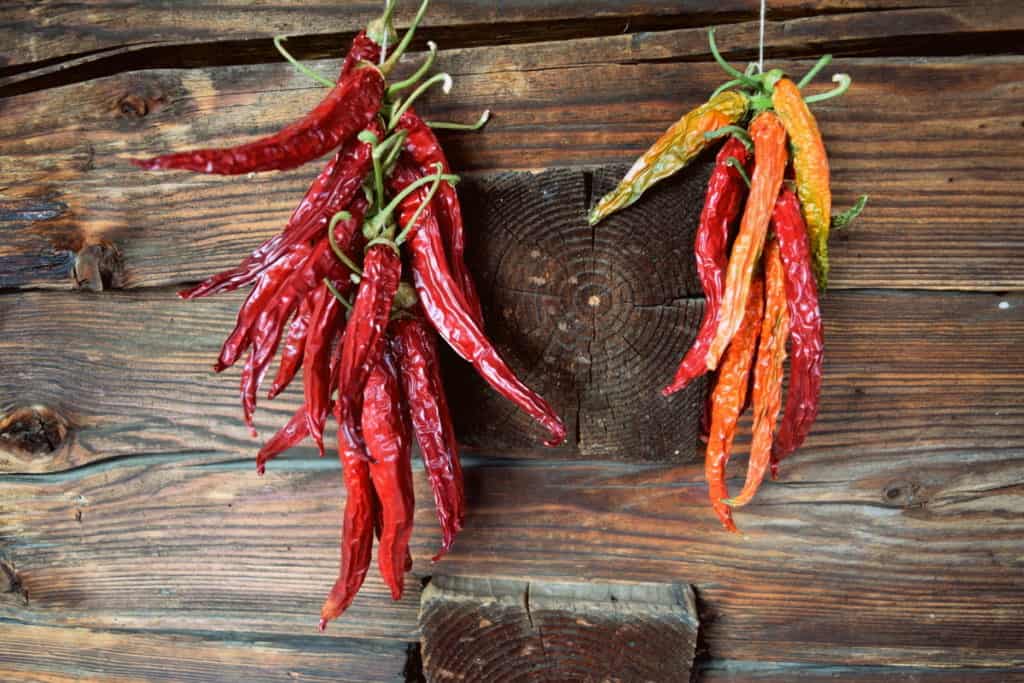
Watching and tending to an abundance of peppers in the garden is a very rewarding experience indeed.
But how many hot peppers can you realistically eat at once? Half of one? Just a slice?
It all depends on how spicy they are – and how much you love them!
Of course, you can always pickle hot peppers to spice up your winter dishes.
However if you are running out of shelf space, or simply don’t have quite enough to fill a jar, then drying hot peppers is definitely the way to go.

Drying hot peppers is incredibly easy.
You can dry a single pepper by tying it on a string and hanging it in the kitchen. Or you can just leave it to slowly dehydrate on its own, resting on a small plate in the windowsill and rotating it on occasion.
Rather than let an overabundance of peppers go to waste, discover a new-old way of preserving them in vinegar or oil, by freezing or drying them.
Come winter, you’ll have plenty of peppery warmth to add to your hearty soups and stews.
Air-drying hot peppers
Depending on the weather, air-drying hot peppers may, or may not, be the best option for preserving.
Simply put, it is the low-tech operation that requires nothing more than a piece of string and access to pure sunlight.

Ingredients and materials for air-drying peppers
It doesn’t take much to get started:
- any quantity of your favorite hot peppers
- string
- scissors
- sewing needle
However, it does take a good deal of time to air-dry hot peppers!
Make sure you have plenty of patience and other things to do in the meanwhile. Harvest your own aloe vera gel, make a bundle of beeswax candles or pick up a new homesteading skill.
Air drying hot peppers takes 2 weeks at a minimum, in ideal conditions. 4 weeks or more if the temperatures drop after harvest – and sometimes they unexpectedly do.
How to air-dry hot peppers – the string method

Step 1 – Carefully wash your hot peppers (from the garden or the market) and let them dry fully from the surface moisture before threading them with string. The most important thing about the entire process of air-drying hot peppers is that they must be fresh! If not, toss them on the compost pile and move on.
Step 2 – Cut a piece of string (hemp and linen are both natural and strong) measuring about an arm’s length. Fold it in two, and thread a sewing needle at one end.
Step 3 – Poke a hole at the base of the stem and pull the thread through, making sure to tie a knot around the lowest hanging pepper stem.

Step 4 – Continue to thread all peppers, one by one. Tie a knot at the top and make a loop to hang the string of peppers.

Step 5 – Hang the peppers in the sun by day, bring them in at night to prevent them from reabsorbing moisture. If you have an outdoor, covered place to hang them, that is the best. If not, hang them in a dry indoor space that is well-ventilated.
Step 6 – Wait. It may take several weeks for your peppers to dry, depending on the variety, size and thickness of the skin.
In the midst of drying these hot peppers, our first frost came, followed by an even deeper second. That’s when they were moved inside above the wood stove to finish drying.
The green peppers turned red and orange, while the red peppers remained red – the wonders of nature!


Once dried, they can be stored as is, though they may get dusty – remember to rinse them before using. They can also be taken off the string and set aside in glass jar, or ground directly into hot pepper flakes.
Using a dehydrator to dry chili peppers
If you have a dehydrator, and it is not in current use for drying fruit, get it out now, for it is the absolute quickest and foolproof way to dry peppers.
You have two options: leave the peppers whole or cut them in half.
Leaving the peppers whole, means that they will take much longer to dehydrate.
If you’d like to shorten the drying time, remove the stems and cut the peppers in half lengthwise, making sure to wear gloves to prevent burns.
With a temperature setting between 135 and 145 degrees Fahrenheit, the chilies should be fully dehydrated in 8-12 hours. Check on them occasionally near the end.
This affordable dehydrator for small-scale drying is perfect for peppers and other vegetables.
If your garden has produced more than theaverage crop, you’ll likely need something larger, with more trays, for more efficient dehydrating – this dehydrator with 6 shelves is one to seek out.
Drying hot peppers in the oven
Faster than air-drying, yet not as fast, convenient or straightforward as a dehydrator, you can also use your oven to dry hot peppers.
Prepare your peppers on a parchment paper lined baking sheet, then set your oven to its lowest setting (125 degrees F) and allow your peppers to sit in the heat for several hours.
The length of time will depend on how large/small and thick-/thin-skinned the peppers are. Leaving them whole is not an option this time around.
For an even dehydrating in the oven, cut the peppers up into smaller, similar-sized pieces to ensure they all get dry at once. Wear gloves to do this and be certain to place the pepper pieces flesh side up.
Make sure that moisture can escape, propping the oven door open a couple of inches.
You will also need to tend to them every hour, rotating and flipping the peppers – always remove the pieces that are done.
There is a fine line between dehydrating and cooking the peppers, make sure you stay on the uncooked side.
What to do with dried peppers?
Naturally, you’ll want to store them among your other spices, making sure to label them – they last three years when properly dried!
You can also pulverize the dehydrated hot peppers and turn them into a powder by using a food processor, spice mill or blender.
Grind them coarsely, or use a mortar and pestle to make the spiciest red pepper flakes you’ve ever consumed.
Rehydrate whole peppers in a pot of chili, or slice them finely for use in salads and pizzas.
Dehydrating herbs, mushrooms, fruits and vegetables is a wonderful skill to learn and, with a very small learning curve, you will be an expert in no time at all!

Get the famous Rural Sprout newsletter delivered to your inbox.
Join the 50,000+ gardeners who get timely gardening tutorials, tips and tasks delivered direct to their inbox.

